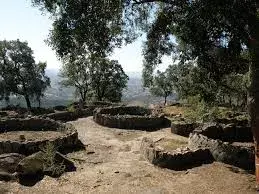Citânia de Briteiros

- Citânia de Briteiros is an ancient Iron Age settlement located near Braga, Portugal. It is one of the most well-preserved and significant Castro culture sites in the Iberian Peninsula, dating back to around the 1st millennium BCE. The site offers a fascinating glimpse into the life of the pre-Roman inhabitants of northern Portugal, known as the Lusitanians or Gallaeci.
- The archaeological site consists of stone-built houses, defensive walls, and paved streets, indicating an advanced and organized community. The circular and rectangular dwellings reflect the architectural style of the time, with some structures showing evidence of later Roman influence. One of the most remarkable features of Citânia de Briteiros is the presence of two large bathhouses, believed to have been used for ritual and hygiene purposes. These baths suggest a sophisticated understanding of water management among the settlement's inhabitants.
- Excavations at the site, first conducted in the 19th century by archaeologist Francisco Martins Sarmento, revealed a wealth of artifacts, including pottery, tools, jewelry, and inscriptions, shedding light on the daily lives of the people who lived there. Some of these artifacts are now housed in the Martins Sarmento Museum in Guimarães. The site is also known for its petroglyphs and inscriptions, offering insight into the region’s ancient writing systems and symbolic representations.
- Today, Citânia de Briteiros is a popular destination for history and archaeology enthusiasts, providing visitors with an opportunity to explore a well-preserved prehistoric fortified village while enjoying scenic views of the surrounding landscape. The site is a testament to Portugal’s ancient cultural heritage and remains an important link to the country’s past before the arrival of the Romans.
